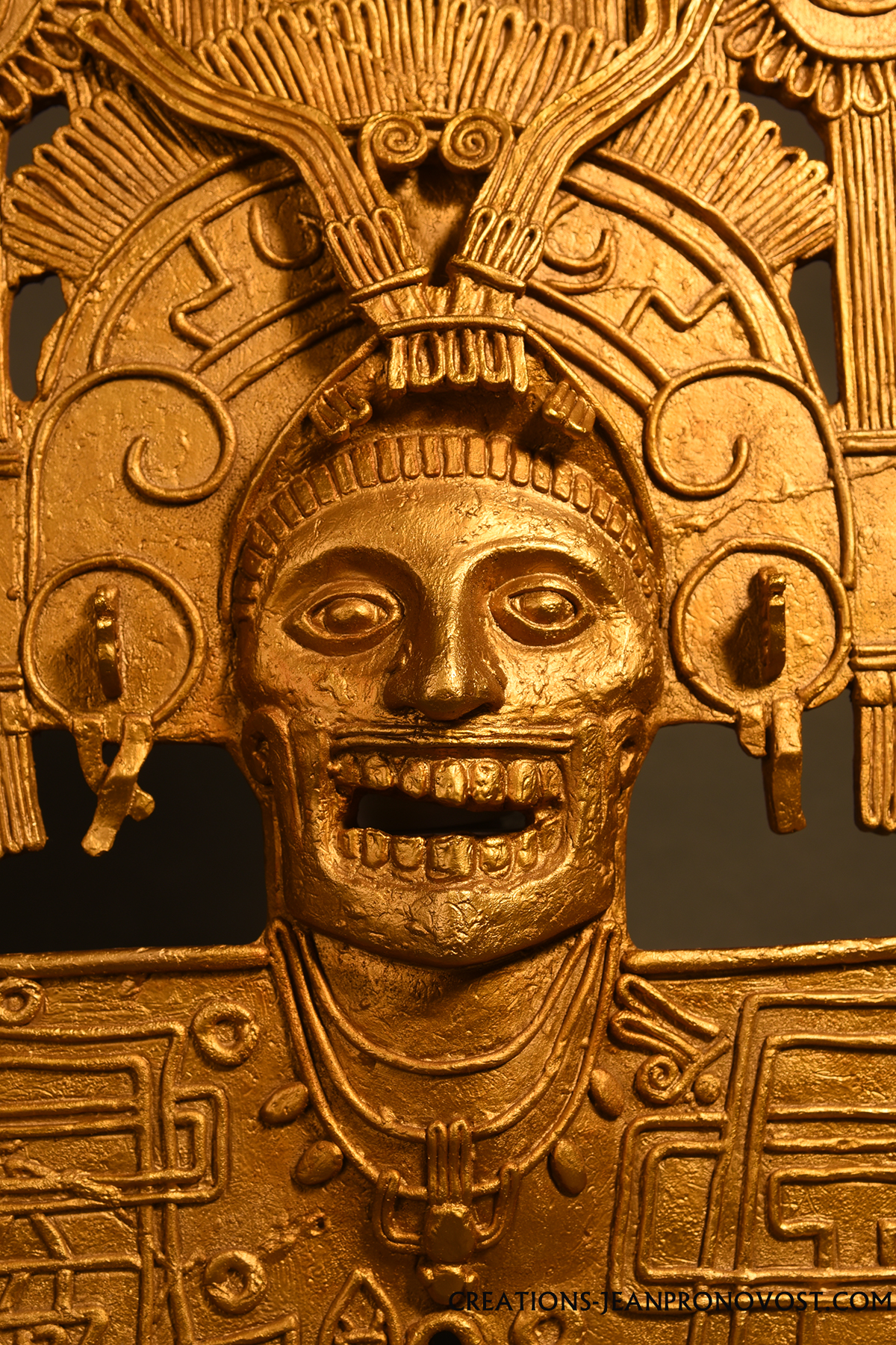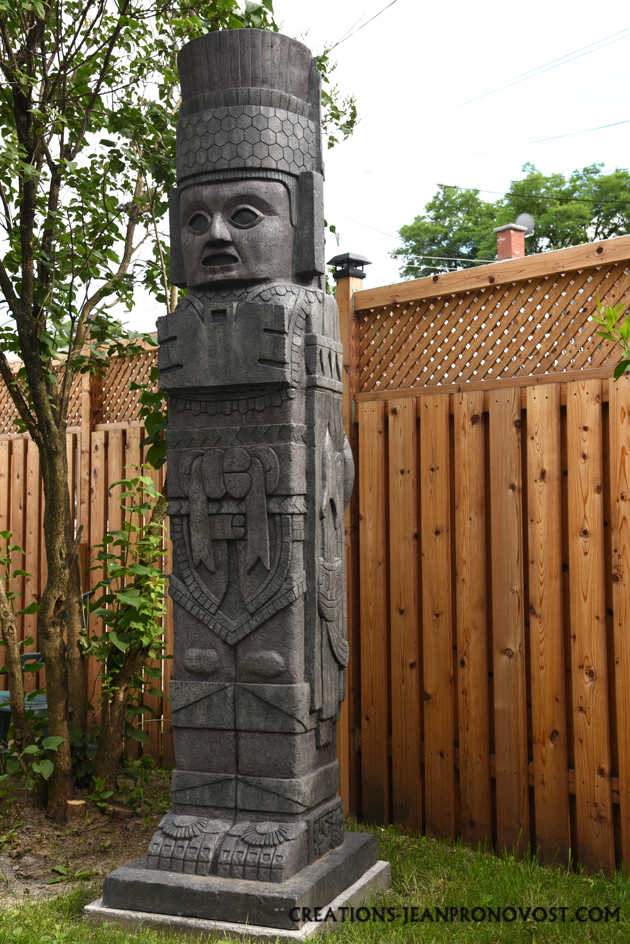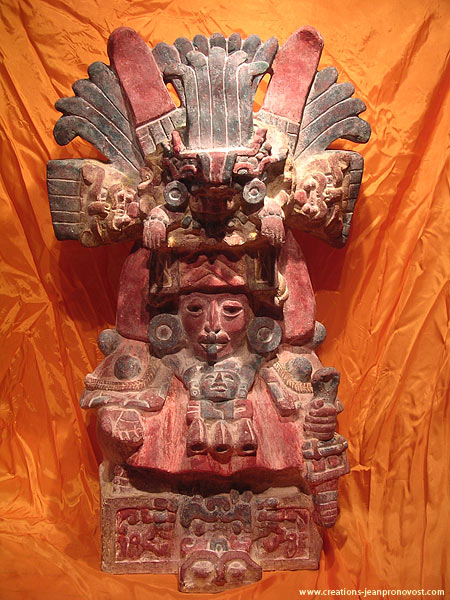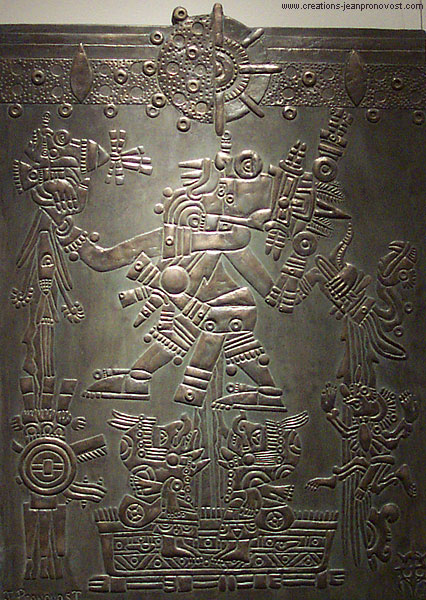Calakmul jade mask sculpture
Price: 2 200$ resin and fiber glass edition, not painted
The Canadian sculptor Jean Pronovost has carved and painted with a faux finish a reproduction of an ancient Mayan jade mask. The mask is considered one of the most beautiful works of art of the Mayan culture; it comes from Calakmul and was carved between 660 and 750 AD. J.C.
The carved reproduction has been carefully elaborated with many references and the proportion as well as its format is faithful to the original sculpture in jade; approximatively 8 by 14.5 inches.
The sculpture was carved from special clay and was remolded several times to look like a polished stone, countless hours of sanding were made to achieve this realistic and convincing result.

The meticulousness and the realism is one of the qualities of the artist sculptor Jean Pronovost, he looked for references and reproduced the sculpture of this famous jade mask from Calakmul.
The story of the Mask is rich and goes back to an almost forgotten era of Mayan history. Its main function was not to be a simple ornamental piece and its history goes back to the years 660 and 750 AD, When it was made to be part of the funeral furniture of a leader, still unidentified, of the Kaan dynasty.
The mask is very complex because it has many elements, not only the face of the king himself, which was worked in a naturalistic way, but also all the symbols made at the time of the death of the sovereign who represents the Mayan cosmogony.

The sculpture of the Mayan mask can be admired here in detail.
You can see the different pieces of jade that have distinct hues, appreciate the polished look of the stone which is actually carved and polished resin, the false finish is exceptional and is very close to the rich vibrant colors that the Mayans cherished so much, several stages of glaze were painted to get there.
The quality of such a sculpture made jean pronovost one the greatest sculptor.
Micltantecuhtli maya mask sculpture
Price: 1 400$ resin and fiber glass edition, not painted
This magnificent sculpture is a larger-than-life reproduction of a famous Mayan masterpiece, the Quebec sculptor Jean Pronovost has carved with great precision all the details of this ancient work with passion and gave it a golden patina, The sculpture of the ancient civilizations masterpieces is one of the strengths of the Canadian artist.
Micltantecuhtli is a Mayan deity who dominates Mictlan; the underworld and the realm of the dead. The original work, which is a massive gold pectoral, is a Mixtec work that was carved during the post-classical period (1000-1697). They occupied the region of Oaxaca in Mexico. In the art of goldsmithing, the Mixtecs have created works of surprising delicacy.
The sculpture is 12 by 16 inches and is made of fiberglass reinforced resin; it can be easily hung on the wall and can even be installed outside because this material is resistant to cold and frost.

We see here the sculpture in detail.
The Quebec sculptor has put a lot of energy to reproduce all the details of Mixtec sculpture, he even reproduced the imperfections of the foundry, and the texture of the metal. The meticulousness of the sculpture was extreme but it is this type of work that fascinates the artist.
For the Quebec sculptor Jean Pronovost it is a pride to have reproduced this pectoral of Mictlantecuhtli because the Mixtecs are regarded as the most extraordinary craftsmen of Mesoamerica during the post-classical period (1000-1697) of pre-Colombian Mexico.

On this picture, we can appreciate the level of infinite details on the reproduction of the Mictlantecuhtli sculpture.
The sculpture of 12 by 16 inches is made of resin reinforced with fiberglass, and it can be easily hung on the wall and can even be installed outside because this material is resistant to cold and frost.
To achieve this result the sculptor Jean Pronovost made a matrix with a special clay, then he molded it and finally, he made a resin edition reinforced with fiberglass, so the result is a resistant sculpture but which has however a multitude of delicate details.
———————————————————————-
Sculpture and creation of a Mayan stelae.
Price: 4600$ resin and fiber glass edition, not painted
The reproduction of ancient work of art is one of the specializations of Creations Jean Pronovost, and what a fine example this is. Shown here is a scale reproduction of a classic Mayan stele from Tikal, Guatemala. The cacique in high relief here is over 2000 years old!

The Mayan stele that we see here seems to us almost to come out of its natural environment, but before this magnificent piece arrives in a garden, it had to be sculpted and painted.
A Maya archive search was first necessary to find photos with good resolution, then sculpting each of the small details was a very long labor and required extreme attention to detail. The satisfaction that results from this work of patience could only be surpassed by the edition which came out of the mold and was painted with a superb faux finish.
Indeed, once the sculpture is finished, this one which we call the matrix must be molded to then be cast and edited in resin and painted with a false finish which will give the appearance to the Mayan stele of having spent more than 2000 years in the Peten jungle.

We see here the sculpture of the finished Mayan stele, the false finish which is in progress here will make it credible, indeed, and a multitude of transparent paint layers will be applied to give it an aspect of naturally aged rock in the jungle. The experience in sculpture added to the experience in painting and especially in faux finish gives results as seen here, more than surprising.
———————————————————————-
Reproduction of the famous Atlantes de Tula, 3.30 meters high.
Price: 12 500$ resin and fiber glass edition, not painted.

The Atlantes de Tula here has been reproduced and sculpted by the creations of Jean Pronovost workshop, This Mexican iconic sculpture was created by the Toltec’s between 8 th and 11 th century AD.
With a height of 4.60 meters, the Atlantes sculpture stood on top of Temple Tlahuizcalpantecuhtli, the god Quetzalcoatl as the planet Venus. Tollan, later named Tula saw the birth of a myth, the myth of Quetzalcoatl. The feathered serpent God myth spread thereafter throughout Mesoamerica.
———————————————————————-
Zapotec decorative sculpture statue
Price: 3 500$ resin and fiber glass edition, not painted.

This 2006 sculpture was cast from the original artwork located in the Mexican Consulate in Montreal. The sculpture represents Cocijo, the god of rain of the Zapotec people, from the region of Oaxaca to the south of central Mexico between 1400 and 700 B.C. Cast in fibre glass, coloured urethane paints and patinas were used to finish the work which measures 18”x 10”x 34”.
———————————————————————-
Low relief sculpture of the Aztec God Tlaloc
Price: 1 600$ resin and fiber glass edition, not painted

Here we see a low relief reproduction of the Aztec God Tlaloc. This relief was conceived in resin on which a oxidized bronze faux fini was layered. The God of rain comes back to life among the symbols of the past which were faithfully reproduced on scale. The molds were then made to create new version with different faux fini to satisfy the needs of ancient sculptures aficionados.
